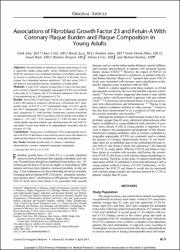Associations of Fibroblast Growth Factor 23 and Fetuin-A With Coronary Plaque Burden and Plaque Composition in Young Adults

Göster/
Tarih
2015Yazar
Akın, FatihÇelik, Ömer
Ayça, Burak
Altun, İbrahim
Diker, Vesile Ornek
Bıyık,İsmail
Kanbay, Mehmet
Üst veri
Tüm öğe kaydını gösterÖzet
Objective: The total burden of subclinical coronary artery disease (CAD) is significant among young adults. Serum fibroblast growth factor 23 (FGF-23) and fetuin-A are established predictors of morbidity and mortality because of cardiovascular disease. The objective of the study was to evaluate the relationship between subclinical CAD and serum FGF-23 and fetuin-A concentrations among a population of young adults. Methods: A total of 241 subjects younger than 45 years who had undergone coronary computed tomographic angiography (CCTA) were included in the study. In 117 patients, the CCTA detected subclinical CAD; the rest of the patients had no CAD detected on CCTA. Results: Serum FGF-23 and fetuin-A levels were significantly increased in the CAD patients as compared with the non-CAD patients (26.7 [interquartile range, 22.4-31.9] vs 15.7 [interquartile range, 13.2-18.1] pg/mL and 904.7 [interquartile range, 695.5-1021.6] vs 469.6 [331.4-660.5] mg/L, respectively; P < 0.001 for both). Furthermore, a positive correlation was identified between FGF-23 and fetuin-A levels and the total number of plaques (r = 0.21 and r = 0.28, respectively; P < 0.001 for both). In multivariate logistic regression analysis, age, smoking status, uric acid, FGF-23, and fetuin-A levels were found to be independently associated with the presence of CAD. Conclusions: The presence of subclinical CAD is independently associated with FGF-23 and fetuin-A and could be used as novel risk markers of cardiovascular disease in the asymptomatic young adult population.

















